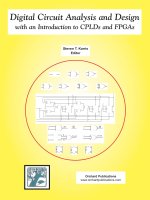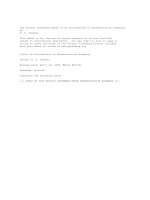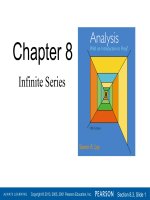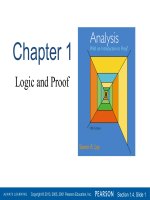Analysis with an introduction to proof 5th by steven lay ch03f
Bạn đang xem bản rút gọn của tài liệu. Xem và tải ngay bản đầy đủ của tài liệu tại đây (220.42 KB, 11 trang )
Chapter 3
The Real Numbers
Copyright © 2013, 2005, 2001 Pearson Education, Inc.
Section 3.6, Slide 1
Section 3.6
Metric Spaces
Copyright © 2013, 2005, 2001 Pearson Education, Inc.
Section 3.6, Slide 2
Definition 3.6.1
Let X be any nonempty set. A function d
: X × X →
is called a metric on
X if it
satisfies the following conditions for all x, y, z ∈ X.
(1)
d(x, y) ≥ 0
(2)
d(x, y) = 0 if and only if x = y
(3)
d(x, y) = d( y, x)
(4)
d(x, y) ≤ d(x, z) + d(z, y)
(triangle inequality)
A set X together with a metric d is said to be a metric space. Since a set may have more
than one metric defined on it, we often identify both and denote the metric space by (X,
d ).
Example 3.6.2
(a)
Let X =
and define d :
×
→
by d (x, y) = | x – y | for all x, y ∈ .
The fact that d is a metric follows directly from the properties of absolute values.
In particular, condition (4) follows from the triangle inequality of Theorem 3.2.10(d).
When we refer to
as a metric space and do not specify any particular metric,
it is understood that we are using this absolute value metric.
Copyright © 2013, 2005, 2001 Pearson Education, Inc.
Section 3.6, Slide 3
Example 3.6.2
(b)
Let X =
×
2
2
=
and define d
d ( ( x1, y1 ),( x2 , y2 ) ) =
for points (x1, y1) and ( x2, y2) in
:
×
2
→
by
( x2 − x1 ) 2 + ( y2 − y1 ) 2
2
.
This metric is called the Euclidean metric on
2
because it corresponds to our usual
measure of distance between two points in the plane.
We can now see why condition (4) is called the triangle inequality. If x, y, and z are the
vertices of a triangle, then (4) states that the length of one side of the triangle must be
less than or equal to the sum of the lengths of the other two sides.
z
y
x
d
Copyright © 2013, 2005, 2001 Pearson Education, Inc.
(x, y)
≤d
(x, z) + d (z, y)
Section 3.6, Slide 4
Example 3.6.2
(c)
Let
X be a nonempty set and define the “discrete” metric d on X by
0, if x = y,
d ( x, y ) =
1, if x ≠ y.
The first three conditions of a metric follow directly from the definition of d.
The triangle inequality can be established by considering the separate cases when
the points x, y, and z are distinct or not.
If x ≠ z, then
d (x, y) ≤ 1 ≤ 1 + d (z, y) = d (x, z) + d (z, y).
If x = z = y, then
d (x, y) = 0 = 0 + 0 = d (x, z) + d (z, y).
If x = z but x ≠ y, then z ≠ y so that
d (x, y) = 1 = 0 + 1 = d (x, z) + d (z, y).
From this example we see that any nonempty set can be made into a metric space.
Definition 3.6.3
Let (X,
d ) be a metric space, let x ∈ X, and let ε
is given by
> 0. The neighborhood of x of radius ε
N (x; ε) = { y ∈ X : d
(x, y) < ε }.
Copyright © 2013, 2005, 2001 Pearson Education, Inc.
Section 3.6, Slide 5
Example 3.6.4
Let’s look again at the examples of metric spaces defined above and see what the
neighborhoods look like geometrically.
(a)
The metric d defined on
The neighborhoods are just open intervals: N (x; ε)
(x,
y) = | x – y | is the usual measure of distance in
.
– ε, x + ε).
2
2
(b) The Euclidean metric on
that are circular disks.
= (x
by d
produces neighborhoods
N(0; 1)
In particular, the neighborhood of
radius 1 centered at the origin 0 = (0, 0) in
is given by
2
–2
2
2
2
N(0; 1) = {(x, y) : x + y < 1}.
–2
(c) The neighborhoods for the discrete metric defined
in Example 3.6.2(c) depend on the size of the radius.
If ε ≤ 1, then the neighborhood contains only the center point itself.
If ε > 1, then the neighborhood contains all of X.
2
In particular, if X =
Copyright © 2013, 2005, 2001 Pearson Education, Inc.
, then N (0; 1)
= {0} and N = .
(0;
2
2)
Section 3.6, Slide 6
Example 3.6.5
For another example, let
X=
2
and define d1 by
d1 ( ( x1, y1 ),( x2 , y2 ) ) = x1 − x2 + y1 − y2 .
It is clear that the first three conditions of a metric are satisfied by d1.
To see that the triangle
inequality also holds, let p1 = (x1, y1), p2 = (x2, y2), and p3 = (x3, y3) be arbitrary points in
Then
2
.
d1(p1, p2) = | x1 – x2 | + | y1 – y2 |
2
= | x1 – x3 + x3 – x2 | + | y1 – y3 + y3 – y2 |
N(0; 1)
≤ | x1 – x3 | + | x3 – x2 | + | y1 – y3 | + | y3 – y2 |
= | x1 – x3 | + | y1 – y3 | + | x3 – x2 | + | y3 – y2 |
–2
2
= d1(p1, p3) + d1(p3, p2)
–2
Geometrically, the neighborhoods in this metric are diamond shaped.
If (X,
d ) is a metric space, then we can use Definition 3.6.3 for neighborhoods to
characterize interior points, boundary points, open sets, and closed sets, just as we did
Most of the theorems from Section 3.4 that relate to these concepts
in Section 3.4 for
.
also carry over to this more general setting with little or no change in their proofs.
Copyright © 2013, 2005, 2001 Pearson Education, Inc.
Section 3.6, Slide 7
One result that does require a new proof is the following theorem.
Theorem 3.6.6
Let (X,
d ) be a metric space. Any neighborhood of a point in
X is an open set.
Proof: Let x ∈ X and let ε > 0. To see that N
ε) is an open set, we shall show that
(x;
If y ∈ N(x
any point y in N (x; ε) is an interior point of N (x; ε).
δ
We claim that N
δ ) ⊆ N (x; ε).
If z ∈ N
then d (z, y)
( y;
( y; δ ),
<δ
; ε), then
=ε− d
y)
(x,
> 0.
N
ε).
(x;
.
It follows that d (z, x) ≤ d (z, y) + d ( y, x)
x
< δ + d ( y, x)
= [ε – d (x, y)] + d ( y, x)
= ε.
N
( y;
Thus z ∈ N
(x;
ε).
It follows that N
( y; δ )
⊆ N (x; ε),
δ )
•
y
•
z
•
and so y is an interior point of N (x; ε), and N (x; ε) is open. ♦
Copyright © 2013, 2005, 2001 Pearson Education, Inc.
Section 3.6, Slide 8
The definition of a deleted neighborhood in a metric space (X, d
N*(x; ε) = {
y ∈ X
) is similar to that in
:
: 0 < d (x, y) < ε }.
The definition of an accumulation point is also analogous: x is an accumulation point
of a set S if for every ε
> 0, N*(x;
Once again, the closure of a set S,
ε) ∩ S ≠ ∅.
denoted by cl S, is given by
cl S ∪ S ′, where S ′ is the set of all accumulation points of S.
The properties of closure and closed sets given in Theorem 3.4.17 continue to apply
in a general metric space. Indeed, the proofs given there were all stated in terms of
neighborhoods, so they carry over with no change at all.
But compact sets are different.
The definition is the same: a set S is compact iff
every open cover of S contains a finite subcover.
But the Heine-Borel theorem no
longer holds.To see this, we first need to define what it means for a set to be
bounded in (X, d
).
Definition 3.6.10
A set S in a metric space (X, d
Copyright © 2013, 2005, 2001 Pearson Education, Inc.
) is bounded if S ⊆ N (x; ε ) for some x ∈ X and some ε
> 0.
Section 3.6, Slide 9
Theorem 3.6.11
Let S be a compact subset of a metric space (X, d
). Then
(a) S is closed and bounded.
(b) Every infinite subset of S has an accumulation point in S.
Proof: (a) The first half of the proof of the Heine-Borel Theorem 3.5.5 was given
entirely in terms of neighborhoods and open sets. It applies without any changes
in this more general setting.
(b) This proof is the same as the proof of the Bolzano-Weierstrass Theorem 3.5.6,
except that the compactness of S is assumed (instead of using boundedness and the
Heine-Borel theorem). We know that the accumulation point of S must be in S,
since S is closed. ♦
While a compact subset of (X, d
not hold in general. The proof of the converse in
very dependent on the completeness of
Copyright © 2013, 2005, 2001 Pearson Education, Inc.
) must be closed and bounded, the converse does
(given in Theorem 3.5.5) was
, a property not shared by all metric spaces.
Section 3.6, Slide 10
Example 3.6.12
2
Consider the set
with the discrete metric of Example 3.6.2(c).
2
N(p; 1) = {p} for every p ∈
.
We have seen that
But neighborhoods are open sets by Theorem 3.6.6,
so each singleton set consisting of one point is an open set.
Since every set is the union
of the points in the set, this means that every set is open! Since the complement of an
open set is closed, this means that every subset is also closed!
= {(x, y): 0 ≤ x ≤2 1 and 0 ≤ y ≤ 1}.
Let S be the unit square: S
and it is also bounded since S ⊆ N
(0; 2)
=
We claim that S is notTocompact.
see this,
.
for each point p ∈ S, let Ap = {p}.
S⊆
Then S is a closed set,
Then each
Ap is an open set and
U Ap .
p∈ S
Thus F
= {Ap
: p ∈ S} is an open cover for S.
But F
contains no finite subcover of S,
since each set in F covers only one point in S and there are infinitely many points in S.
We conclude that in this metric space the unit square S is closed and bounded, but not
compact.
Copyright © 2013, 2005, 2001 Pearson Education, Inc.
Section 3.6, Slide 11









